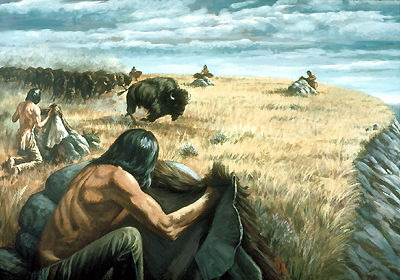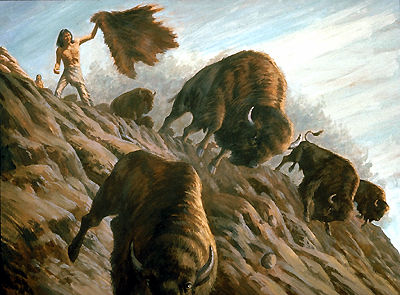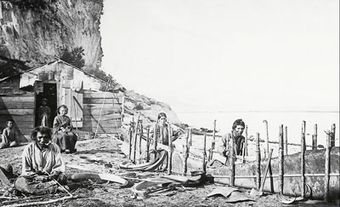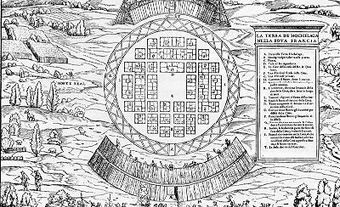
Who are the Plains Indigenous Peoples?
Indigenous peoples in Canada, both historical and contemporary, can be divided into six cultural areas that, unlike provinces and countries, do not have strict boundaries, and instead refer to areas in more general terms. The Plains is one of these cultural areas. The others include the Arctic, Plateau, Subarctic, Northwest Coast and Eastern Woodlands.
Various Indigenous nations call the Plains their traditional territory, such as the Siksika, Piikani, Kainai, Dakota, Stoney Nakoda, Cree, Assiniboine and Tsuut’ina. Before epidemics in the early 1800s drastically reduced the population, Plains Indigenous people in what is now Canada numbered an estimated 33,000.
After sustained contact with Europeans, many Indigenous women, largely Plains Cree, intermarried with these newcomers, giving birth to the Métis — a culturally distinct Indigenous people. Though intermarriage was not uncommon in other areas of Canada and significant Métis communities exist elsewhere, many cite the Plains as the physical, cultural and political home of the Métis people.
Geography
The Plains cultural area generally refers to the southern portions of Alberta and Saskatchewan, and southwestern Manitoba. This area has a continental climate — hot and dry summers and very cold winters. High grass covers the rolling prairies in the east; short grasses, sage and cacti the arid high plains to the west. Flat land and rolling hills extend in all directions. Flowing eastward, rivers have cut deeply into the land, and provide practically all the scarce available water. Tree growth on the high plains is restricted to these valleys, becoming rapidly more noticeable toward the margins of the area. This is the area that many Plains Indigenous peoples called home.
Traditional Life
Early Settlement
Small bands of hunters roamed the Plains beginning at least 11,000 years ago. (See also Prehistory.) For several thousand years, bison hunting was conducted primarily with the use of spears, but around 200 CE a group known as the Avonlea people (because they lived during the Avonlea period) specialized in bowhunting. Some sources have the Avonlea people arriving in the southern Saskatchewan and Alberta in 100 CE. By 1000 CE, they engaged in some agriculture, but continued to rely primarily on nomadic bison hunting.
Food
Traditionally, Plains people relied on seasonal fruits, vegetables and game for subsistence. Nuts, roots, berries were especially prevalent staples of the Plains diet. Fish was a regular supplement to bison meat for some Plains peoples.
While women gathered and cultivated, hunting — a predominantly male activity — provided the bulk of food. Plains hunters used animal-skin disguises to lure bison into traps or get close enough to a herd to kill bison on the periphery with bows and arrows. Hunters also directed bison to stampede over steep cliffs and fall to their death. While the horse greatly facilitated bison hunting, muzzleloading guns proved inferior to bow and arrows; Plains hunters switched away from bows and arrows only after more convenient breech-loading rifles were introduced by the 1860s.
Women were primarily responsible for processing the spoils of the hunt. Some parts of the bison that were eaten immediately could be raw or cooked, but most was sliced and sun-dried for the winter or ground and mixed with fat and berries to make pemmican.
Dwellings and Transportation
When moving to a new camp, family property was transported by pack dogs. After 1776, some Indigenous peoples on the Plains used the travois, a triangular frame of poles, dragged by dogs. Dogs were domesticated independently by Indigenous peoples in North America, though they were quickly replaced by European breeds after contact. In some cases, the travois provided the framework of the dwelling called a tipi, a cone of poles covered with bison skins. After the introduction of the horse, the increased carrying capacity made the construction and transport of larger travois and tipis possible. Snowshoes were used during the winter by some peoples on the northern Plains.
Clothing
Women made clothing for their families, often using the skins of antelope, deer and bison: breechcloth, leggings and shirts for men, long dresses and leggings for women. They also made robes and moccasins, sometimes out of bison hides. Bison was versatile; in addition to providing meat for food, the animal’s horns, bones, sinew and hide were used to fashion tent covers, shields, tools and utensils.
Culture
As Indigenous cultures varied across the Plains, artistic expression ranged from tattoos, to clothing painted or embroidered with dyed porcupine quills, to painted tipi covers, shields and rawhide container. Plains art also included carvings on wooden bowls, horn spoons and stone pipes. These items often featured symbols associated with the Indigenous nation or the identity of the particular band member who made the designs. (See also History of Indigenous Art in Canada.)
Plains peoples are credited with having held the first powwows, events that allow various Indigenous nations to come together in celebration of their cultures. Wearing regalia adorned with sacred eagle feathers, beads and colourful items, Plains Indigenous peoples perform powwow songs and dances. Drums used in these ceremonies represent the Earth or the circle of life, and as such, are considered important to the culture and spirituality of many Plains Indigenous peoples. Some of the songs played at powwows are healing songs, others tell a particular story; all of them, however, are considered sacred. (See also Powwow Singers and History of Powwows.)
Culture Change
Contact between Plains peoples and European fur traders and settlers rapidly accelerated societal change, which had traditionally moved much more gradually. The introduction of metalwares made pottery, stone chisels and arrowheads obsolete in the mid-18th century; glass beads gradually replaced quillwork and by the mid-19th century cloth became as common as animal skins for clothing.
The Indian Act and other federal legislation and policies that encouraged assimilation, such as residential schools, threated Indigenous cultures on the Plains and elsewhere in Canada. The Indian Act forbade powwows and many other cultural events. Forced onto reserves, the traditional hunting practices of the Plains Indigenous peoples became a thing of the past. Despite this cultural upheaval, Indigenous peoples have persevered. Powwow traditions and Indigenous languages, among other aspects of their cultures, have survived into the present day. Efforts to protect and preserve Indigenous culture aim to make sure art, language and more do not disappear.
Language
The languages spoken by the Indigenous people of the Plains in Canada belong to three linguistic families. Algonquian languages are spoken by the Blackfoot Confederacy (see also Siksikáí’powahsin: Blackfoot Language), Plains Cree (Nêhiyawak) (see also Cree Language), Gros Ventre (Atsina) and Plains Ojibwe (see also Anishinaabemowin: Ojibwe Language.) Siouan languages are those of the Assiniboine (Nakota), Stoney Nakoda and Dakota. The Tsuut’ina language (known as Sarcee) is part of the Athapaskan (or Dene) language family. (See also Indigenous Languages in Canada.)
Languages from separate linguistic families are completely different, and within each family, languages may be similar but are not the same. This linguistic diversity and the high mobility of the Plains population encouraged the development of communication by means of hand gestures or sign language.
Indigenous people in this area still speak a number of Plains languages. In the 2016 census, significant populations reported fluency in Cree, Anishinaabemowin (Ojibwe), Siksikáí’powahsin (Blackfoot) and Stoney Nakoda. The Métis language, Michif, evolved from a mixture of French and Plains Cree, while a variant called Bungee (largely considered extinct) is comprised of a mixture of English, Scottish Gaelic, Ojibwe and Cree. In 2016, 725 people reported Michif as their mother tongue. With less than 1,000 speakers, Michif is considered an endangered language. Language revitalization efforts are underway in some Métis communities.
Social Organization
The adaptability of the Plains people to their natural environment, and in particular to the movements of the bison herds, is reflected in their social organization. Most nations consisted of loosely organized and independent bands. Chiefs held the respect and support of the band as long as they were successful in the quest for food and in defence against enemy attacks. Bands moved around independently of each other, while in lean periods, smaller groups formed and split off to increase the likelihood of finding sufficient food.
When the bison were concentrated in large herds more conducive to group hunting, the bands would come together for a few weeks in one large tribal encampment. There the Plains people joined together in the large celebrations that were the principal means of tribal cohesion. After the performance of the Sun Dance and possibly a bison drive, the bands separated again; in the fall they moved to well-protected campsites in river valleys, foothills and parklands, where they spent the winter.
Religion and Spirituality
Religious ideas and practices permeated all aspects of daily life. People prayed for, or hoped for, help or power (or a guardian spirit) from spirit beings. An individual seeking such power went to a lonely spot where he or she would fast and pray until a spiritual guardian appeared in a dream, or vision quest. Mystical experiences sometimes gave rise to cults that either disappeared when the initiator died, or became increasingly popular. (See also Religion and Spirituality of Indigenous Peoples in Canada.)
In the late 19th century, for instance, a practice called the Ghost Dance rose among the Plains people in both Canada and the United States. In its earliest forms, the ritual prophesied the return of the dead and the restoration of animals then becoming scarce on the Plains. Some Dakota (Sioux) practitioners also believed the garbs worn during the Ghost Dance would protect them from White settlers’ bullets. Believing the Ghost Dance had warlike connotations (because it was wrongly blamed for the rise of the armed outbreak in late 1890 that ended in the massacre at Wounded Knee, South Dakota), the dance was suppressed violently by the United States authorities, who forbade its practice on reservations in South Dakota. Though the Ghost Dance was not performed much in Canada, police took steps to discourage its practice.
European Colonization
First Contacts
Spanish conquistadors moving north from Mexico introduced horses to the southern Plains in the 17th century. The animals spread north through intertribal trade and raiding, reaching the Canadian Plains by the 1730s. The use of horses altered hunting techniques and enabled the people to transport larger and more comfortably furnished dwellings. The use of horses also led to the rise of horse raiding as the most common form of intertribal warfare. Typically, small war parties would raid enemy territory, run off the horses and sometimes kill a few people.
The arrival of Europeans around this time brought the Plains peoples into contact with settlements to the east, and from 1730 to 1870, Plains peoples played an important role in the fur trade, which in turn profoundly altered their way of life. Adjusting hunting patterns to meet the demands of the traders, Plains people gradually moved away from a subsistence lifestyle towards one of trade and interdependence.
For more than a century, the fur trade was the sole method of contact between Europeans and the Plains people in Canada. These early encounters led to the spread of European diseases among the Plains people — in particular smallpox, which broke out several times on the Plains beginning in the 1730s and sometimes wiped out entire bands. (See also Health of Indigenous Peoples in Canada.) Survivors were left with shaken world views and undermined or entirely compromised support systems. As external support was largely provided by European missionaries — often seen as both cause and cure for disease — sick and malnourished Plains peoples were not just vulnerable to illness and death, but to cultural and spiritual transformation as well.
Treaties and White Settlement
In 1870, the Crown purchased Rupert’s Land from the Hudson’s Bay Company, and in a series of treaties, known as the Numbered Treaties, between 1871 and 1877, secured a number of land cessions from various Indigenous nations. By this time, the bison herds had been virtually eliminated, and the integrity of many Plains communities had been severely compromised by White traders’ introduction of hard liquor. As disease and hunger ravaged Indigenous populations on the Plains, government-sponsored settlers arrived from the east in numbers that overwhelmed underprepared provincial authorities. The resulting settlement produced much tension and violence, which precipitated, among other reasons, the arrival of the newly formed North-West Mounted Police in 1874.
The Canadian government, led by Prime Minister John A. Macdonald, held White settlement and development of the Plains as a top priority, and regularly used aid and rations as bargaining chips with sick and starving Indigenous peoples. By 1891, nearly 250,000 White settlers had arrived on the Canadian prairies, and their numbers were rising exponentially. (See also History of Settlement in the Canadian Prairies.)
The Red River and North-West Resistances of 1869-70 and 1885, respectively, were uprisings against the Canadian government aimed at protecting Indigenous ways of life, but both were ultimately defeated, and in November 1885, Métis leader Louis Riel was hanged for treason.
Reserves and Residential Schools
By this time, most Indigenous people had been forcibly relocated to reserves, where federal Indian agents tried to introduce them to new means of subsistence, primarily agriculture. By 1885, over 17,500 Plains Indigenous people had settled on reserves. Though some bands managed to subsist successfully, most faced a severe food crisis. Those who did not enter the reserves pursued the remaining herds of bison in Montana. Years of scarcity and starvation followed, in which the people depended upon frequently inadequate government rations, which were only allotted to bands that had signed treaties with the Crown. (See also Pass System in Canada.)
Throughout this difficult period of social and economic transformation, missions of various Christian denominations played a major role in providing a new education system, frequently acting as mediators between Indigenous and non-Indigenous peoples. With the Indian Act, first passed in 1876, the government promoted assimilation, and used joint government and Christian missionary programs like residential schools to further those aims. By 1899, approximately 70 per cent of Indigenous people in Canada were associated with some church denomination.
Political Organization
Indigenous leaders made efforts to establish provincial organizations through which they could articulate their social and economic needs. Starting in the 1920s, organizations like the League of Indians in Western Canada — formed in 1929 at Green Lake, Saskatchewan — struggled against government harassment and apathy among their own people, slowly beginning to lift the oppressive paternalism of government policy. (See also Indian.)
After the Second World War, the activities of such Indigenous-led organizations began to increase, forcing the federal government to take notice. (See also Indigenous Political Organization and Activism in Canada.) On reserves, various economic programs have been initiated and the government has increasingly transferred administrative responsibilities to elected chiefs and tribal councils. The Indian Act was partially amended in 1951, and later in 1985, to remove some outdated and discriminatory practices, and Indigenous people were granted the right to vote in federal elections in 1960. (See also Indigenous Suffrage in Canada.)
Contemporary Life
Indigenous activism for the right to self-determination has steadily grown on the Plains, with movements achieving increasing levels of success. Organizations like the Saskatchewan Indian Cultural Centre (now the Saskatchewan Indigenous Cultural Centre) (1972), the Assembly of Manitoba Chiefs (1988), the Saskatchewan Indian Federated College (now First Nations University of Canada) (1976) and many other organizations continue to advocate for the revitalization of Indigenous rights, culture and education. In addition, many nations are exercising political and economic self-determination, like the Whitecap Dakota First Nation near Saskatoon, which owns and operates a golf course, a casino and many other profitable businesses on its territory.

 Share on Facebook
Share on Facebook Share on X
Share on X Share by Email
Share by Email Share on Google Classroom
Share on Google Classroom






